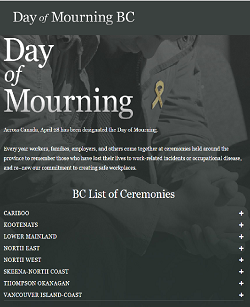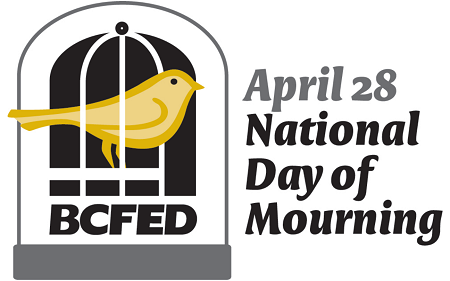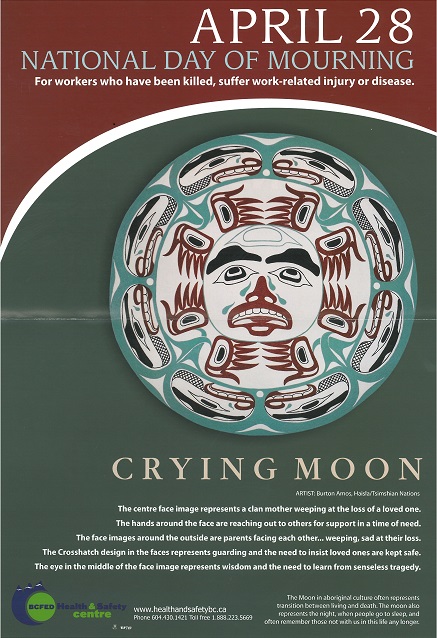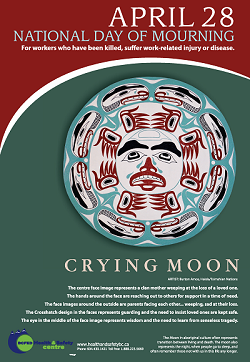BCFED Health & Safety Centre
National Day of Mourning posters are available.
To order, contact us at ohsadmin@bcfed.ca (fee applies to orders exceeding 10 units) or click on the image to download the PDF (for free).
CLC's Day of Mourning Statement
(Canadian Labour Congress)
Day of Mourning Golden Tree Poster
(BC Federation of Labour)
April 28 – National Day of Mourning
 Each year on April 28, we pause to remember workers who lost their lives, and to recognize the lasting impact on those whose lives and livelihoods have been compromised by work-related injuries or illnesses.
Each year on April 28, we pause to remember workers who lost their lives, and to recognize the lasting impact on those whose lives and livelihoods have been compromised by work-related injuries or illnesses.
But we can never pause our prevention efforts.
Here's a more succinct, bullet-point version for a website, focusing on actionable steps for remembering and promoting worker health and safety:
What can you do?
- Attend or organize a community or workplace event.
- Share stories of workers injured or killed, ensuring they are not forgotten.
- Promote awareness through your organization's website, publications, and local media.
- Encourage the lowering of flags to half-mast at workplaces and public institutions.
- Utilize available resources like the BCFED OH&S Centre DOM Poster and Day of Mourning in Schools Project.
Every Day of the Year:
- Educate on health and safety rights, responsibilities, and prevention.
- Demand effective workplace prevention programs with full worker participation.
- Insist on training for hazard identification, assessment, and control.
- Encourage media to report on health, safety, and environmental issues.
- Advocate for stronger regulations and better enforcement with elected officials.
- Support the creation of monuments to raise public awareness.
- Become a workplace health & safety representative.
- Actively identify and report workplace hazards.
The BCFED Health & Safety Centre can help. We take the time to ensure everyone gets the proper training - hazard-based, prevention-focused, worker-to-worker - where and when you need it.
PREVENTION THROUGH EDUCATION


Every year, thousands of people gather around the world on April 28th to observe the National Day of Mourning. The purpose of Day of Mourning is twofold – to remember and honour those lives lost or injured because of their work and to renew the commitment to prevent further deaths, injuries and diseases by improving health and safety in the workplace.
April 28th is observed in many different ways around the world.
Many labour organizations, unions, families, communities and government agencies coordinate public events that include speeches, a moment of silence, laying wreaths and flowers, lighting candles, planting trees, unveiling monuments, balloon releases, laying out empty shoes or hard hats to symbolize those who have died at work. Some events involve active campaigning on relevant issues, public demonstrations or workplace or public awareness sessions that provide information regarding occupational health and safety.
Individuals don ribbons, black armbands, bracelets, or stickers to show their support. Workers on the water, in trains or in transport trucks will often blow their whistle or horn at 11:00 am in honour of the day. The Canadian flag on Parliament Hill is typically flown at half-mast, as it is in many other communities.
THE FACTS
British Columbia
As reported to the Workers Compensation Board, in 2017:
• 198 workers died
• 6 young workers
• 102 died from occupational disease
Canada
According to the Association of Workers’ Compensation Boards of Canada, nationally:
• Every year, approximately 1000 workers die.
• Every day, nearly 3 workers die.
• Every year, workers suffer from 250,000 work-related injuries/diseases.
• Every day, workers suffer from 685 work-related injuries/diseases.

Internationally
More people die each year because of work than because of fighting in wars.
According to the International Labour Organization (ILO), across the world:
• Every year, more than 2.3 million workers die
• Every day, 6,300 workers die
• Every year, workers suffer from 317 million work-related injuries
• Every day, workers suffer from 870,000 work-related injuries
• Every year, workers suffer from 160 million non-fatal occupational diseases
• Every day, workers suffer from 440,000 non-fatal occupational diseases
Of these fatalities, reportedly 2.02 million workers died as a result of occupational disease.
Around the world, every 15 seconds…
• 1 worker dies
• 151 work-related injuries are reported
• 76 non-fatal occupational diseases are reported
THE HISTORY
The Day of Mourning has a very proud Canadian Labour history. At the Canadian Labour Congress (CLC) convention in 1984, a resolution was submitted by the Canadian Union of Public Employees (CUPE) National Health and Safety Committee recommending the creation of a day of remembrance for workers killed or injured on the job – this resolution was readily adopted by the convention delegates. The date April 28th was chosen as on April 28 in 1914 the first comprehensive workers compensation act was passed in the legislature.
The CLC officially declared and recognized the National Day of Mourning on April 28, 1985. In Canada, over 25,000 workers have died due to work-related injury or disease since 1985.
In December 1990, following years of lobbying efforts by Canadian unions and the NDP, the federal government passed Bill C-223, the Workers Mourning Day Act, make April 28, 1991 the first government recognized National Day of Mourning. The Act is a brief piece of legislation, which reads, in part:
“Throughout Canada, in each and every year, the 28th day of April shall be known under the name of Day of Mourning for Persons Killed or Injured in the Workplace.”
This movement quickly spread outside of Canada. In the United States in 1989, the American Federation of Labour began to recognize April 28th as Workers’ Memorial Day. The United Kingdom (UK) began their campaign to recognize this day in 1992. Workers’ Memorial Day was adopted by the Scottish Trade Union Congress (TUC) in 1993, the UK TUC in 1999 and the UK Health and Safety Commission in 2000.
The International Labour Organization (ILO) and the International Trade Union Congress (ITUC) declared the International Day of Mourning in 1996. Let us carry on the international cry to: “MOURN for the Dead and FIGHT for the Living!”




